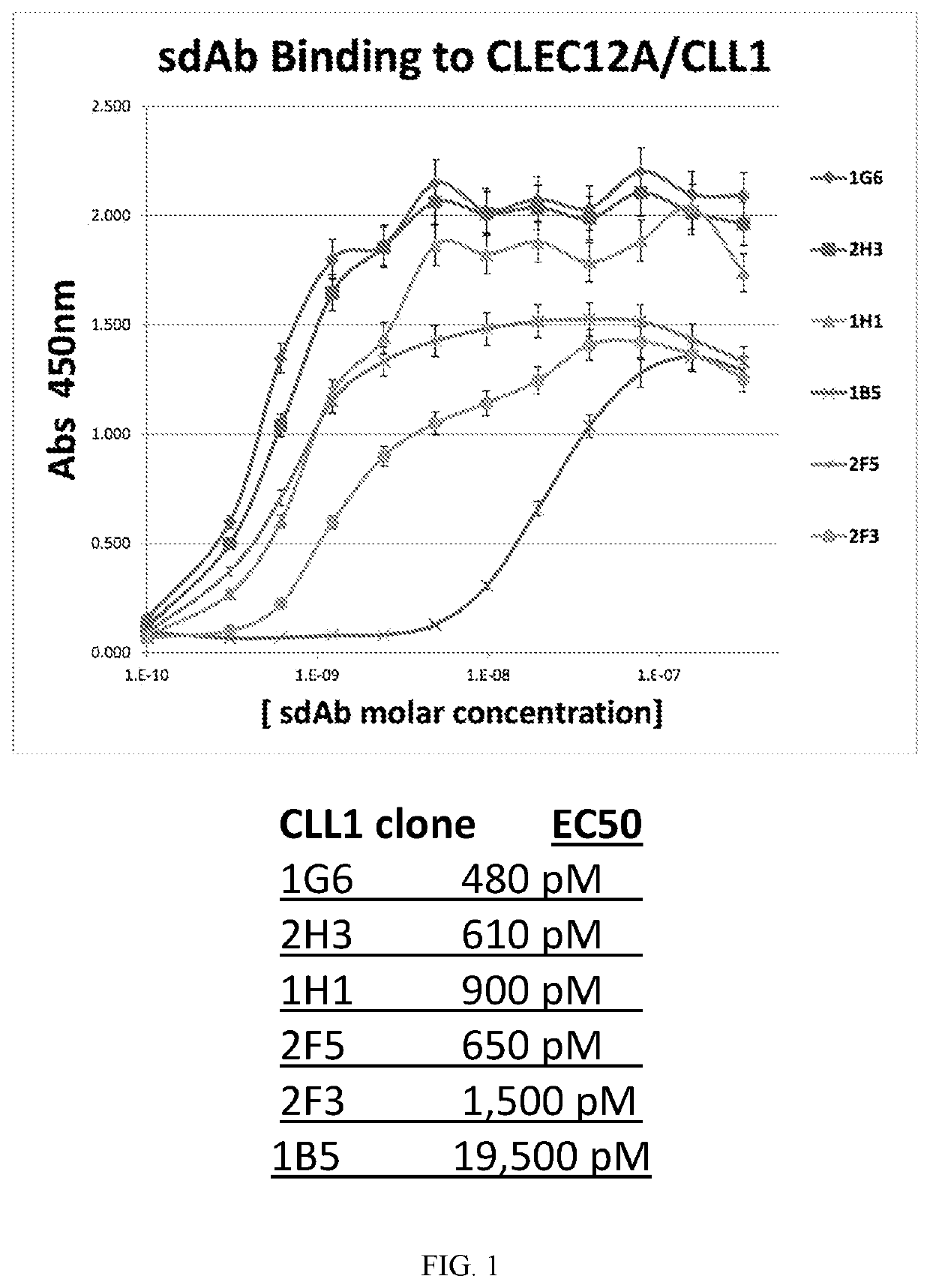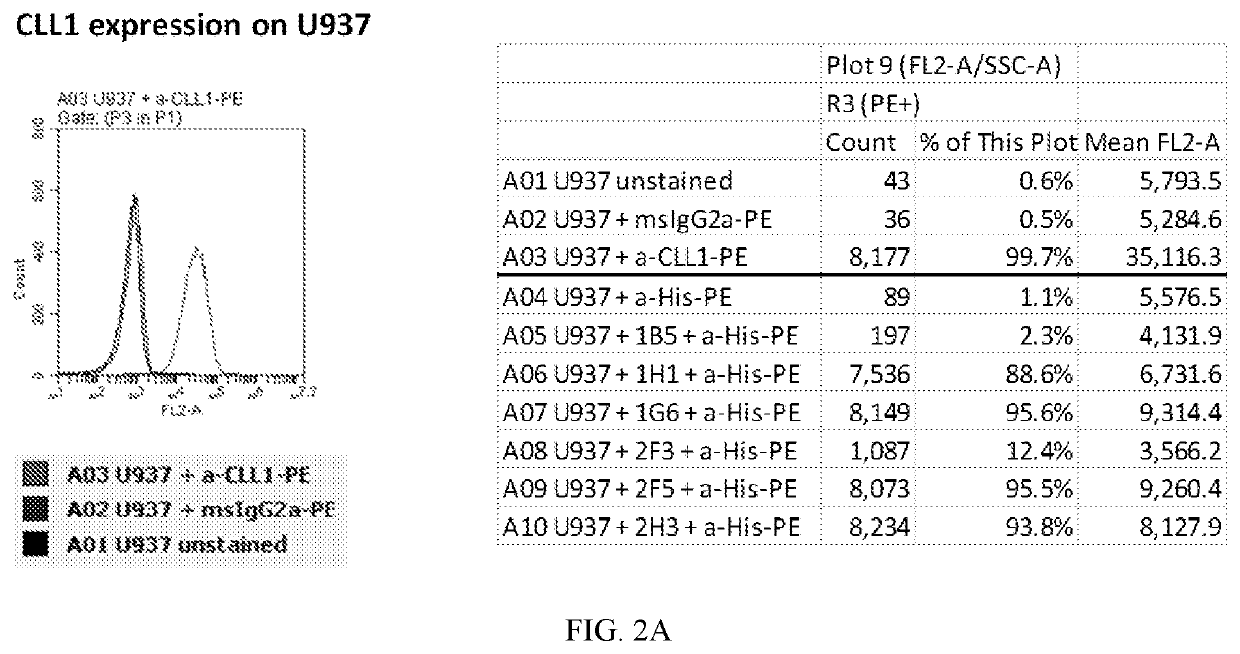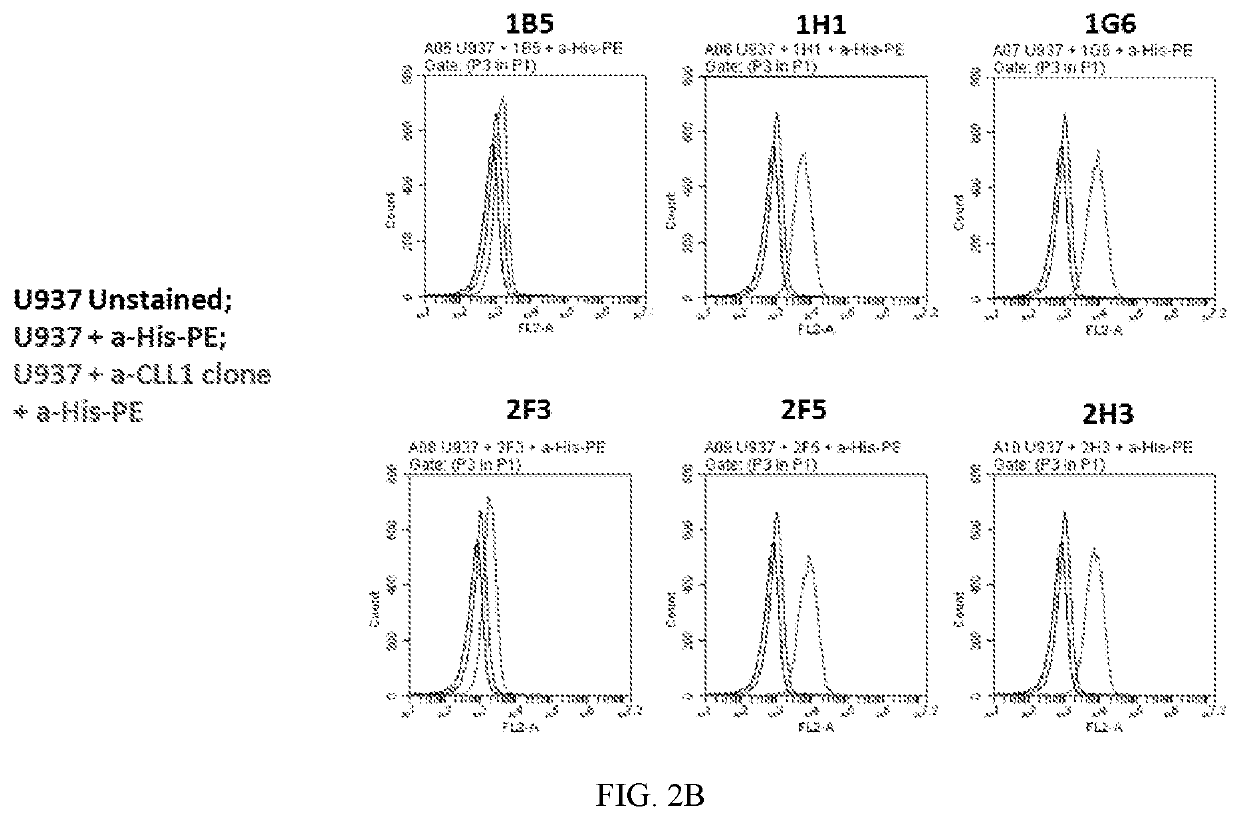Single domain antibodies against cll-1
a single-domain antibody and antibody technology, applied in the field of single-domain antibodies against cll1, to achieve the effects of reducing the severity or frequency of the disease, and preventing or delaying the onset of the diseas
- Summary
- Abstract
- Description
- Claims
- Application Information
AI Technical Summary
Benefits of technology
Problems solved by technology
Method used
Image
Examples
example 1
t of VHH Antibodies
[0118]The clones described in the Examples have the amino acid sequences noted in Table 2.
TABLE 2CloneSequence1B1, 2A6, 2A10, 2C5, 1B2, 1B3, 1B8, 1C2,SEQ ID NO: 31C3, 1C10, 1E11, 1G2, 1H9, 2D7, 2D11, 2D3,2B3, 2B8, 1A61A9, 1C7, 1F2, 1D6, 2C11, 2E3, 2B6SEQ ID NO: 42G11, 2H2, 1G6SEQ ID NO: 52F6, 2A7SEQ ID NO: 61C8 and 1H6SEQ ID NO: 71C9, 1A8, 1B12, 2F10, 2G3SEQ ID NO: 81G4, 1H11, 1F10SEQ ID NO: 91G3 and 2H10SEQ ID NO: 102C8SEQ ID NO: 112F5SEQ ID NO: 122A11SEQ ID NO: 131A10SEQ ID NO: 142H3SEQ ID NO: 152F4 and 1H1SEQ ID NO: 161C6SEQ ID NO: 171D2SEQ ID NO: 181B5SEQ ID NO: 192F3SEQ ID NO: 202A8SEQ ID NO: 212G10SEQ ID NO: 22IE3SEQ ID NO: 231B11SEQ ID NO: 242C2SEQ ID NO: 25
[0119]Around 184 sdAb samples were screened for binding to CLEC12A (also known as CLL-1), coated onto a plate, by ELISA. Plates were coated with 1 μg / mL human CLEC12A in PBS (O / N 4C), then blocked with 5% milk / PBST (2 hr, room temp); added bacterially expressed sdAbs diluted in 1:1 in Block (1 hr), washe...
example 2
apping
[0127]One or more of the following methods are used to define the binding epitope for each antibody. Epitopes are either linear or conformational. A linear epitope is composed of a linear stretch of amino acids in the sequence that does not form 3-dimensional structure. A conformational epitope is one that requires tertiary folding to create the proper binding region. Epitope mapping techniques are used for identifying either linear or conformational epitopes. However, linear techniques do not map conformational epitopes. Linear techniques include peptide array scanning, scanning mutagenesis, peptide library phage display and related techniques that define the amino acids found in the linear epitope. These linear techniques are used to map the epitope of antibodies that can bind to a non-conformational part of the antigen, e.g., as is known for antibodies that can bind to denatured proteins that have had their conformations disrupted. Most epitopes are conformational and are d...
example 3
s Recognize an Epitope Distinct from Previously Reported Anti-Clec12A scFv
[0129]To further elucidate epitopes bound by the VHH clones, several VHH clones were tested for their ability to compete for binding with a known anti-Clec12A scFv. A fusion protein comprising the anti-Clec12A scFv SC02-357 described in U.S. Pat. No. 7,741,443 (included herein as SEQ ID NO:26) was immobilized on plastic plates followed by binding of recombinant Clec12A. Three biotinylated VHH clones, 1A10, 1B1, and 2H3, each from the same epitope cluster, and a negative control of biotinylated Clec12A (lane 1), were then evaluated for binding. Each of the three clones was able to bind the Clec12A pre-bound to the anti-Clec12A scFv. This result (FIG. 9) demonstrates that the epitope recognized by the anti-Clec12A scFv is distinct from the epitope recognized by the VHH clones.
PUM
| Property | Measurement | Unit |
|---|---|---|
| temperature | aaaaa | aaaaa |
| concentration | aaaaa | aaaaa |
| nucleic acid sequence | aaaaa | aaaaa |
Abstract
Description
Claims
Application Information
 Login to View More
Login to View More - R&D
- Intellectual Property
- Life Sciences
- Materials
- Tech Scout
- Unparalleled Data Quality
- Higher Quality Content
- 60% Fewer Hallucinations
Browse by: Latest US Patents, China's latest patents, Technical Efficacy Thesaurus, Application Domain, Technology Topic, Popular Technical Reports.
© 2025 PatSnap. All rights reserved.Legal|Privacy policy|Modern Slavery Act Transparency Statement|Sitemap|About US| Contact US: help@patsnap.com



